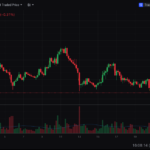Stablecoin activity on the Ethereum network is reaching new heights in 2025, with $1.1 billion in inflows recorded over the past week, according to data from Lookonchain. This surge follows a significant turnaround from last week’s $63 million in outflows, highlighting increased investor activity and renewed optimism in the market.
Ethereum and Solana Lead the Way
Ethereum continues to dominate as the primary destination for stablecoin inflows, while Solana follows with $202 million over the same period. Notably, Solana’s figure represents a decline from the $424 million it attracted the previous week. Other blockchain networks such as TON, Avalanche, and Polygon have also seen notable stablecoin activity, with inflows of $22 million, $83 million, and $43 million, respectively.
In contrast, Arbitrum and Optimism have faced substantial outflows, shedding $2 billion and $14 million, respectively, over the past seven days. This divergence highlights varying sentiment across blockchain ecosystems, with Ethereum and Solana emerging as key beneficiaries.
Trump’s Win and Market Optimism
Market analysts attribute this surge in stablecoin activity to growing investor confidence tied to Donald Trump’s recent presidential victory. Reports from Citibank suggest that since the election, stablecoin market capitalization has grown by over $25 billion, signaling investor hope for more crypto-friendly policies under the new administration.
Stablecoins like USDT and USDC have particularly benefited, with Coingecko data revealing their combined value locked across blockchains stood at $181 billion as of December 31. This growth aligns with increased adoption of Layer 2 solutions, where Ethereum’s stablecoin activity alone reached $13.5 billion in December.
The Global Shift Towards Stablecoins
Stablecoins are no longer confined to niche use cases. A Bloomberg report from December highlighted the growing interest of global banks in stablecoin technology. European institutions, such as Société Générale, have already launched Euro-backed stablecoins under the regulatory clarity provided by the EU’s Markets in Crypto-Assets (MiCA) regulations. MiCA, which became effective on December 30, is expected to accelerate the adoption of regulated stablecoins across Europe.
Meanwhile, industry leaders predict further growth in 2025. An Aptos Labs engineer recently highlighted a 4x increase in daily stablecoin transactions since the start of the year, signaling broader adoption trends.
What’s Next for Stablecoins and Ethereum?
The sharp rise in stablecoin inflows on Ethereum suggests growing investor interest, which could serve as a precursor to a broader market rally. However, the divergence in network activity highlights the importance of closely monitoring individual blockchains and market sentiment.
For investors, this surge presents an opportunity to assess stablecoin-focused projects or blockchain ecosystems poised to benefit from increasing adoption. Ethereum’s dominance in this space continues to make it a leading contender, while networks like Solana and Polygon also show promise.
Final Thoughts
The stablecoin market is evolving rapidly, with 2025 poised to be a transformative year. Whether this activity leads to a sustained rally or merely reflects temporary optimism remains to be seen. Investors should weigh the risks and consider diversifying across promising blockchain ecosystems.
This article is for informational purposes only and should not be considered investment advice.







